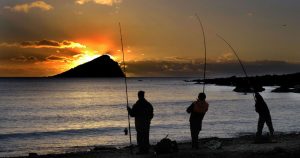Anglers Fishing for Mullet

Grey mullet can be found almost anywhere along our coastline but their favourite haunts are harbours, rivers and tidal estuaries. They congregate under the walkways of marinas, under wharfs and far up the rivers where the sea meets with fresh water. They feed on marine insects that hide among weed and sift the mud in estuaries looking for tiny crabs and shrimps.

As the tide flows into a river or estuary they can often be seen on the surface in good numbers. The first fish to move in on the flood tide are the tiddlers followed by fish of increasing sizes. Even the big ones can be seen feeding in as little as a foot of water.

Tactics for catching mullet differ from most other sea species and often the tackle used is more akin to the gear used by course anglers. Anglers often employ carp rods with small fixed spool reels and ultra light line as these fish tend to study the bait rather than just rushing in. Best baits are bread crimped to a size 6 or 8 hook due to them having quite small mouths. Anglers have success with small ragworm or maggots but bread is often the number one choice.

The popular methods for fishing in deeper water are free lining or small floats. If the fish are feeding at the surface then a lightly crimped piece of bread floating on the surface is worth a try. For the bread to sink below the surface put a single small shot on the trace. Be careful not to crimp the bread too tightly to the hook but rather squeeze it to the eye end and lightly to the rest of the hook making sure none of the hook is visible to the fish.

Floating bread works in shallow water when estuary fishing although the more common method is to use a simple Paternoster rig with one or two short traces above a small weight. One ploy is to overload the top hook with a large piece of bread and a smaller lightly crimped piece on the bottom hook. The fish sometimes attempt to knock bits off the larger piece and they then think the bottom piece is for eating. Using ultra light gear you don’t really want to have two mullet on at the same time as a pair of 4lb plus specimens would prove to be quite a challenge.

Mullet can be easy to catch when they are hungry but are mostly very cautious. Rather than take the bread they will just suck on it or try and dislodge it from the hook with their tails. They can certainly test an angler’s patience at times. Once hooked they are one of the best fighting fish in home waters but the angler must exercise extra care by carefully playing them due to their soft upper lip. In most cases a landing net is essential as lifting a good size specimen is not really advisable.



